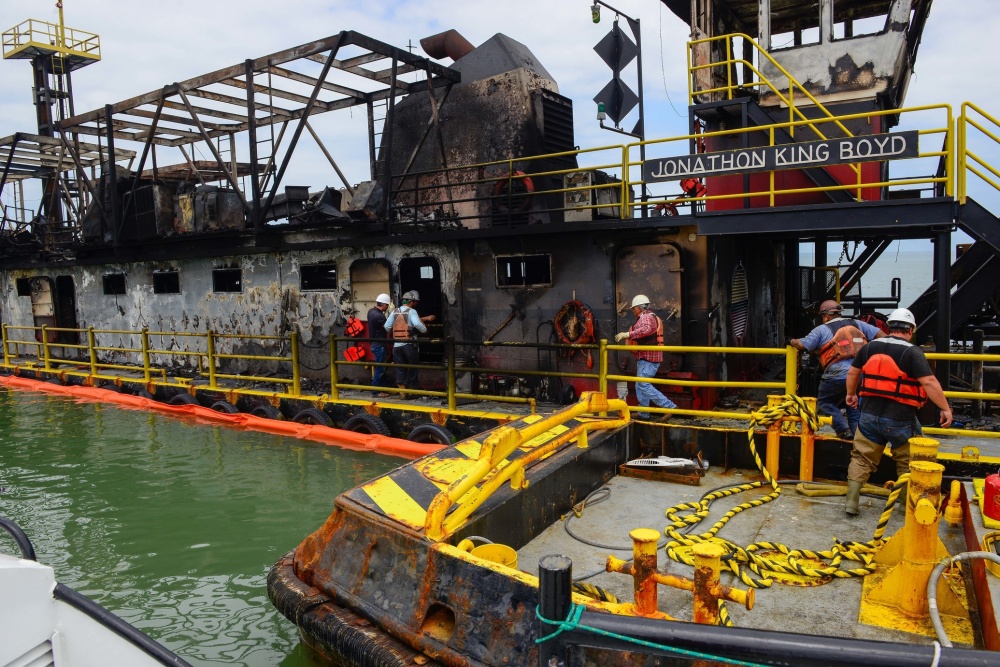The dredge Jonathon King Boyd was destroyed by fire on Tuesday evening, April 17 when it dropped a spud onto a gas pipeline. All 10 crew members were rescued by the good Samaritan vessel First State, belonging to Great Lakes Dredge & Dock (GLDD).
The dredge, which belongs to RLB Contracting of Port Lavaca, Texas, was working about two miles from Port O’Connor on the Gulf Intracoastal Waterway (GIWW) Main Channel across San Antonio Bay, on contract for the Galveston District when gas from the ruptured pipeline, belonging to Genesis Energy, ignited, surrounding the dredge in flames.
The Coast Guard Sector/Air Station Corpus Christi watch standers received a mayday call at 8:10 p.m. and diverted an HM-65 Dolphin helicopter crew to the location.
The Corpus Christi station also launched an HC-144 Ocean Sentry aircrew, and Coast Guard Station Port O’Connor launched a 29-foot response boat soon after the incident was reported.
The Coast Guard established a 4-mile safety zone around the scene, closed the GIWW to traffic from Mile Marker 468 to Mile Marker 474, and closed the Matagorda Ship Channel from the jetties to seven nautical miles inside the bay.
A Unified Command consisting of the Coast Guard, the Texas General Land Office, Genesis Energy and RLB Contracting Inc. conducted damage assessments of the pipeline. On April 19, the Galveston Engineer District’s 26-foot hydrographic survey boat CC01 performed a sidescan survey of the area to ensure that the damaged pipe did not protrude from the ocean floor, and to confirm that there was no longer natural gas being released from the pipeline. With no hazards to navigation present, the safety zone was reduced to one mile.
The dredge was safely towed to Port Lavaca and moored at an RLB Contracting Inc. facility on April 19.
After completing the damage assessments of the damaged pipeline, the command reopened all the waterways near Port O’Connor, on Friday, April 20.
“I’m proud of the work our response teams have done to ensure we were able to open the waterways as quickly and safely as possible,” said Capt. Tony Hahn, Sector/Air Station Corpus Christi commanding officer.
The Coast Guard is investigating the incident, but no date for publication of the results has been announced.
Corps Investigation
A Corps four-member Board of Investigation convened in Galveston on May 1 to conduct site visits, review documents and conduct interviews. Team members come from other districts and divisions throughout the country, and include a contracting officer, project engineer and senior quality assurance technician, along with an advisor from the Galveston District, all with experience in dredging projects.
The inspection team does not have criminal or civil legal investigatory authority but uses its findings to ensure safe and accident-free operations.
Safety requirements are set forth within contracts that include known hazards. The investigation team will conduct a thorough review to determine if these hazards were identified, stated a Corps spokesperson.
The Corps team has 45 days to complete its report.
“Damage to the Jonathon King Boyd was an unfortunate loss for Randy Boyd and RLB Contracting Inc., and we are working with his company during this difficult time. There are over 1,300,000 cubic yards of material remaining to be dredged under the current schedule. We are awaiting a response to determine the proposed schedule of work to complete the project by October 15, 2018,” the Corps spokesperson said.
The Galveston District released a statement saying, “The U.S. Army Corps of Engineers is committed to working with contractors to conduct safe dredging operations and is grateful no injuries or loss of life occurred.”
Dave Blackburn Fire
The dredging industry has long been aware of the danger presented by submerged pipelines. An incident on October 23, 1996, revealed a safety issue within the industry that resulted in dredging contractors amending their safety procedures.
At 4:50 a.m. on that day, the Bean Horizon dredge Dave Blackburn dropped a stern spud onto a 12-inch gas pipeline in Tiger Pass, Louisiana. The pipeline was owned by the Tennessee Gas Pipeline Company.
The pressurized (about 930 psig) gas released from the pipeline enveloped the stern of the dredge and the tug G.C. Linsmier. Within seconds of reaching the surface, the gas ignited, and the resulting fires destroyed the dredge and tug. All 28 crewmembers from the dredge and tug escaped into the water or onto nearby vessels.
The National Transportation Safety Board (NTSB) report on the incident described the detailed communication the crew had had with the pipeline company to inform it of the dredging operations planned for the vicinity of their pipe crossing. However, because the reported location of the pipe was in error, the dredge crew believed the dredge was 140 feet from the pipeline and moving away from it, when it was moving toward the pipeline. The cutterhead passed over the pipe without incident, but when the spud dropped, it hit the pipeline.
The report acknowledged Bean Horizon’s safety program for its vessels, which included initial crew-changeout, monthly abandon ship and man overboard drills, and weekly all-hands safety meetings. These drills and safety meetings were recorded in the vessel’s logbooks and written summaries were submitted to the company Loss Control Department.
Important Safety Issue
The investigation into the Bean Horizon dredge revealed an important safety issue – the lack of a crew list, crew team assignment, or other crew accounting procedure in place on the vessel.
“No crewmember interviewed after the accident knew with certainty how many people were on the vessels at the time of the accident. They stated that they used an informal survey and quick head count to determine that no one was missing,” the report stated.
“The Safety Board has investigated several accidents aboard passenger and fishing vessels in which passenger and crew accountability was an issue,” stated the investigation report. “In (the Tiger Pass) accident, the speed and extent of the gas release and fire placed all crewmembers in grave danger. Fortunately, despite the early hour, most crewmembers were awake, alert, and able to respond quickly to the emergency. Given the rapid ignition of the gas and the extent of the damage to the vessels, had this accident occurred while the crew was sleeping, serious injuries or fatalities may have occurred.”
The Safety Board concluded that in even a slightly more serious accident, Bean’s emergency procedures were not adequate to account for and facilitate the rescue of missing crewmembers. The Safety Board made the following recommendation to Bean Horizon Corporation in Directive M-98-124:
“Amend your emergency response procedures to require that an accurate count of all persons aboard your vessels be maintained at all times by someone in authority on the vessel and be accessible to the vessel operating department on shore so that the number will be readily available to emergency responders in the event of an on-board emergency.”
NTSB also asked the Western Dredging Association (WEDA) to make the same recommendation to its members, which it did in December 1998. The Safety Board issued Safety Recommendations P-98-25 to the Research and Special Programs Administration; P-98-26 and –27 to Tennessee Gas Pipeline Company and M-98-123 to Bean Horizon Corporation; P-98-28 to the Interstate Natural Gas Association of America and P-98-29 to the American Petroleum Institute.
NTSB is an independent federal agency with the statutory responsibility “to promote transportation safety by conducting independent accident investigations and by formulating safety improvement recommendations” (Public Law 93-633.)




